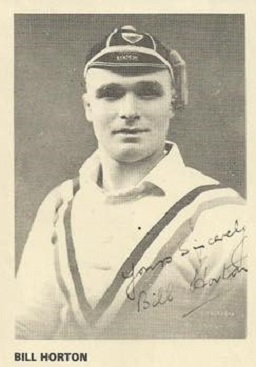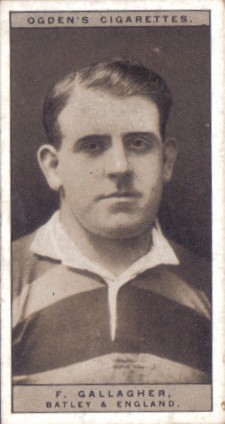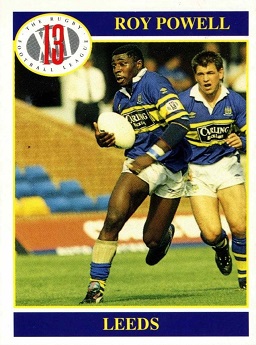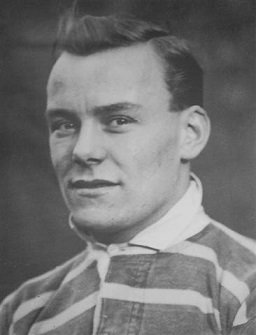Brian Lockwood is an English World Cup winning former professional rugby league footballer who played in the 1960s, 1970s and 1980s, and coached in the 1980s. He played at representative level for Great Britain, England and Yorkshire, and at club level for Castleford, Canterbury-Bankstown, Balmain, Wakefield Trinity, Hull Kingston Rovers, Oldham and Widnes, as a prop or second-row, during the era of contested scrums, and coached at club level for Wakefield Trinity, Huddersfield and Batley.
Deryck Fox is an English former professional rugby league footballer who played in the 1980s and 1990s, and coached in the 1990s, 2000s and 2010s. He played at representative level for Great Britain, England and Yorkshire, and at club level for Featherstone Rovers, Western Suburbs Magpies, Bradford Northern, Batley and Rochdale Hornets, as a scrum-half, and coached at club level for Rochdale Hornets, Shaw Cross ARLFC, Batemans Bay Tigers and Dewsbury Celtic. He attended St John Fisher's RC High School in Dewsbury.

William Horton was an English professional rugby league footballer who played in the 1920s and 1930s. He played at representative level for Great Britain, England and Yorkshire, and at club level for Wakefield Trinity (captain), as a second-row, or loose forward, i.e. number 11 or 12, or 13, during the era of contested scrums.
Keith Rayne is an English former professional rugby league footballer who played in the 1970s, 1980s and 1990s, and coached in the 1990s. He played at representative level for Great Britain and England, and at club level for Wakefield Trinity (captain), Leeds and Doncaster, as a prop or second-row, and coached at club level for Batley.

Frank Gallagher, was an English professional rugby league footballer who played in the 1920s. He played at representative level for Great Britain, England and Yorkshire, and at club level for Dewsbury, Batley and Leeds, as a stand-off, scrum-half, second-row, or loose forward, i.e. number 6, 7, 11 or 12, or, 13, during the era of contested scrums.
Stephen John Molloy is an English former professional rugby league footballer who played in the 1990s and 2000s, and coached in the 2000s. He played at representative level for Great Britain and England, and at club level for Warrington, Leeds, Featherstone Rovers (captain), Sheffield Eagles, Oldham, Huddersfield-Sheffield Giants, Huddersfield Giants and Batley Bulldogs, as a prop, i.e. number 8 or 10, and coached at club level for Oldham. Steve is the current Head Coach of the ambitious Manchester Rangers RLFC who are currently working on plans to enter the semi-professional & professional ranks in the near future.
Jeffrey Grayshon MBE was an English professional rugby league footballer who played in the 1970s, 1980s and 1990s, and coached in the 1990s. He played at representative level for Great Britain and England, and at club level for Dewsbury, Cronulla-Sutherland Sharks, Bradford Northern, Leeds, Featherstone Rovers and Batley, as a fullback, prop, second-row, or loose forward, and coached at club level for Batley. Grayshon continued playing until he was 45 for Batley before taking over as coach at Batley. Jeff's biography "The Warrior: Jeff Grayshon MBE" was written by Maurice Bamford.
George Curran was an English professional rugby league footballer who played in the 1940s and 1950s. He played at representative level for Great Britain and England, and at club level for Salford, Dewsbury, Wigan, Huddersfield and Liverpool City, as a prop, hooker, or second-row, i.e. number 8 or 10, 9, or, 11 or 12, during the era of contested scrums.
George Dickenson was an English professional rugby league footballer who played in the 1900s and 1910s. He played at representative level for Great Britain and England, and at club level for Warrington, as a centre, i.e. number 3 or 4.

James Wasdale Brough, also known by the nickname of 'Gentleman Jim' , was an English dual-code international rugby union, association football (soccer) footballer, and professional rugby league footballer who played in the 1920s and 1930s, and rugby league coach of the 1940s and 1950s. He played representative level rugby union (RU) for England and Cumberland, and at club level for Silloth RUFC, as a fullback, and club level association football as an amateur for Liverpool, as a goalkeeper, and representative level rugby league (RL) for Great Britain (captain), and England, and at club level for Leeds, as a fullback, or centre, and coached representative level rugby league (RL) for Great Britain, and at club level for Batley and Workington Town. Born in Silloth, Cumberland, England, he died in Workington, Cumbria, England.

Roy Colin Powell was an English professional rugby league footballer who played in the 1980s and 1990s. He played at representative level for Great Britain, and at club level for St John Fisher, Leeds, Bradford Northern, Featherstone Rovers, Batley and Rochdale Hornets, as a prop, or second-row, i.e. number 8 or 10, or 11 or 12.
George Davidge was an English rugby union, and professional rugby league footballer who played in the 1920s. He played club level rugby union (RU) for Plymouth Albion R.F.C., and representative level rugby league (RL) for England, and at club level for Huddersfield and Batley, as a centre, i.e. number 3 or 4.
Frederick Hill was an English professional rugby league footballer who played in the 1900s and 1910s. He played at representative level for England, and at club level for Batley, as a forward, during the era of contested scrums.
A. George Palmer is an English former professional rugby league footballer who played in the 1950s. He played at representative level for England, and at club level for Batley, as a second-row, i.e. number 11 or 12, during the era of contested scrums.
Lee Harland is an English former professional rugby league footballer who played in the 1990s and 2000s. He played at representative level for England, Yorkshire, Great Britain U21 and at club level for Leeds, Halifax, Castleford Tigers, Doncaster and Batley Bulldogs, as a second-row, or loose forward, i.e. number 11 or 12, or 13.

Leonard Charles Bowkett was an English rugby union, and professional rugby league footballer who played in the 1920s and 1930s, and coached rugby league in the 1930s. He played representative level rugby union (RU) for Warwickshire, and at club level for Coventry R.F.C., and representative level rugby league (RL) for England, and at club level for Huddersfield, Batley (loan), and Keighley, as a fullback, centre, stand-off, i.e. number 1, 3 or 4, or 6, and coached at club level for Keighley (A-Team).
Edward Tattersfield was an English professional rugby league footballer who played in the 1930s and 1940s, and coached in the 1940s. He played at representative level for England, and at club level for Reckitt ARLFC, Hull Kingston Rovers, Leeds (captain), Halifax, Batley and Hull F.C., as an occasional goal-kicking second-row or loose forward, i.e. number 11 or 12, or, 13, during the era of contested scrums, and coached at club level for Hull F.C. and the Hull Dockers. Ted Tattersfield was a Corporal in the British Army during World War II.
Charles "Charlie" Henry Glossop was an English professional rugby league footballer who played in the 1920s and 1930s, and coached in the 1930s. He played at representative level for England, and at club level for Wakefield Trinity, Leeds and Batley (captain), as a forward, during the era of contested scrums, and coached at club level for Batley.
George Henry Exley, also known by the nickname of 'Mick', was an English rugby union, and professional rugby league footballer who played in the 1920s, 1930s and 1940s, and coached rugby league in the 1940s. He played representative level rugby league (RL) for Great Britain, England and Yorkshire, and at club level for Wakefield Trinity (captain) and Hanging Heaton WMC ARLFC, as a wing and later as second-row, i.e. number 2 or 5, or, 11 or 12 during the era of contested scrums, and club level rugby union (RU) for Wakefield RFC Old Boys, and coached at club level for Batley.
Harry Dyer was an English professional rugby league footballer who played in the 1930s. He played at representative level for England, and at club level for Leeds, as a second-row i.e. number 11 or 12, during the era of contested scrums.


